EASY DOES IT
BY IAN DOIG • LEAD PHOTO COURTESY OF DUCK FOOT PARTS
Farmers naturally gravitate toward equipment that simplifies their work and is easy to use. The products featured here are intended in some way to make farm operations more convenient and less complex. Some are brand new, while others were launched ahead of their time and have since evolved.
FEET OF ENGINEERING
This duck is anything but daffy.
Govan, SK, farmer-turned-equipment manufacturer Steve Kastning created a slip-over paddle tine to improve the performance of combine headers. This practical idea sprung from his own frustration with inefficient header performance during lentil harvest. He tinkered with homemade attachments made of belting and duct tape to better clear the cutter bar. Much more sophisticated, the final version is a UV-resistant resin paddle that slips over the factory tine and hooks onto the reel pipe but is easily removable.
On-farm testing in 2016 led to the first sale of Duck Foot paddle tines to an Australian farmer in 2017. Officially launched at the Canada Farm Progress Show in Regina in 2018, it won a sterling award for innovation.
Annual growth has been significant, and Kastning and his wife Chrisa now operate Duck Foot Parts full time. Marketed across North America, Australia and Germany, Kastning aims to expand sales further abroad.
He emphasized the device is gentle with the harvest. This includes beans, soybeans, canola, wheat, barley and more. For all crops he recommends slowing the reel speed, riding higher on the crop and being less aggressive with reel pitch.
“Duck Foot helps make farms more efficient and sustainable,” he said. Based on field data, it notably improves handling of heavy crops, he added. Kastning has calculated the product delivers a 27 per cent increase in ground speed on average across all crops. Additionally, data show the rate of header loss decreases by 75 per cent on average. “Regardless of your crop conditions, there are big advantages with the Duck Foot,” said Kastning. “You’re going to reduce your environmental impact because you spend less hours on your machines, burn less fuel and see less wear and tear.”
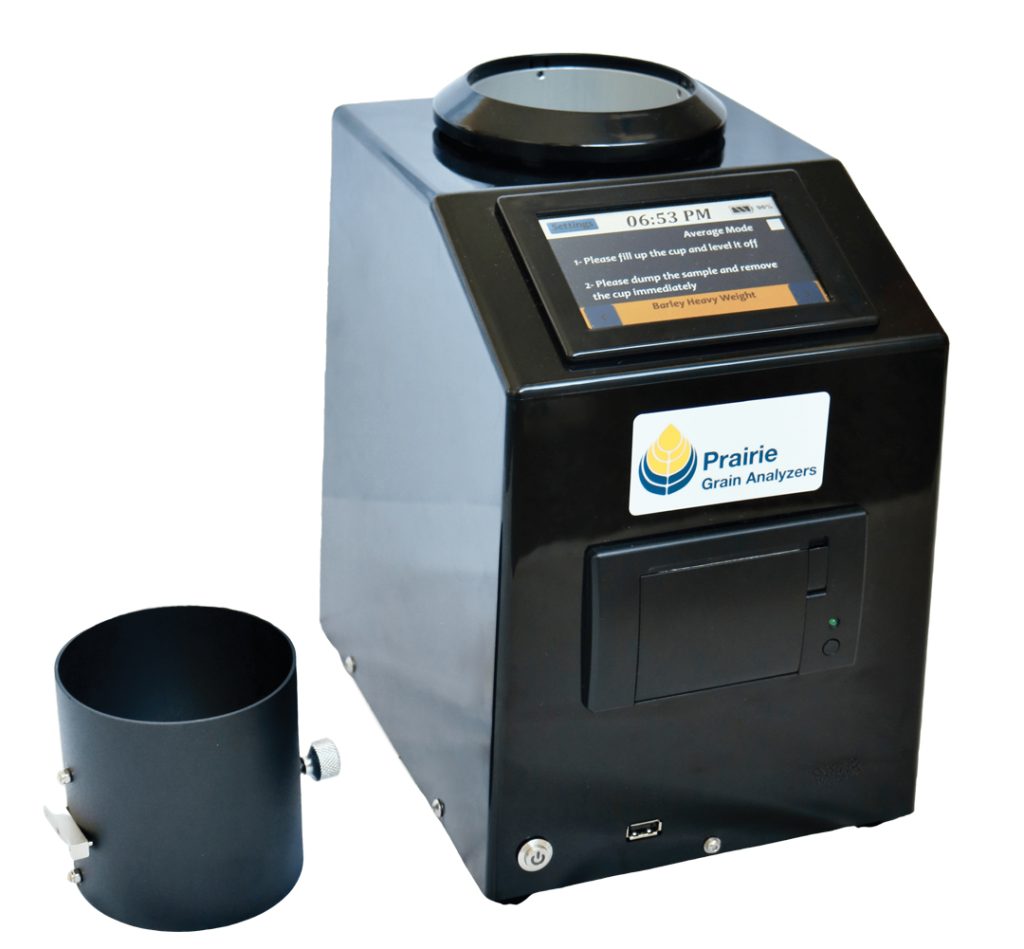
MOISTURE MEASUREMENT
The MA 405 Moisture Analyzer looks something like a bread maker. Though it can measure the moisture level, test weight and temperature of wheat destined to make dough, it is calibrated to analyze 49 additional crop types. For use in the field, it is portable and durable, and its rechargeable lithium battery holds a five-hour charge.
The tester is manufactured in Winnipeg, MB, but the Prairie Grain Analyzers head office is in the small community of Oak Bluff just southwest of the city. Though its hometown is tiny, the company’s sales are continental. It is widely available throughout Canada and the U.S.
Owner Mehrdad Bagherzamani has worked in seed cleaning plants and grain elevators where moisture testing is regularly carried out. He observed the need for on-farm testing equipment that is portable, quick and accurate and can analyze hot and cold grain. His first tester was manufactured in 2017 and redesigned in 2019.
Going beyond surface moisture, the MA 405 uses high frequency technology to measure through to the centre of the kernel. “That allows for accurate results, especially when you’re dealing with higher moisture or a range of temperatures,” said Prairie Grain Analyzers sales representative Nick Matichuk.
The device’s accompanying app can be downloaded to a smartphone and the tester linked by Bluetooth. The user must key in the crop type, fill and level the sample cup and dump it into the unit’s barrel. Readings appear on its screen and in the app, which stores the data from specific fields and bins.
Bluetooth connectivity is a popular feature, but the device’s inkless printout is also a hit with clients, said Matichuk. Typically, they are inserted into the sample as a handy reference to compare numbers at the elevator. “It’s one less thing to write down,” added Matichuk.
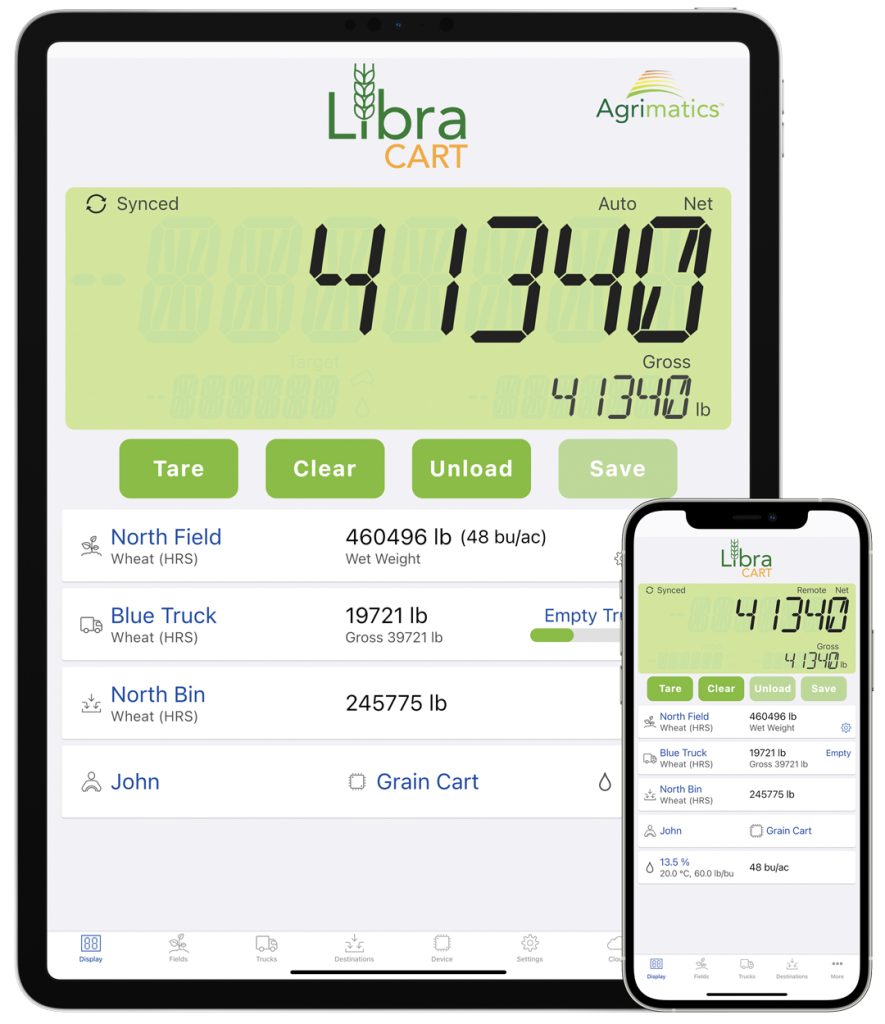
TRACK AND ROLL
Engineers Ian Meier and Michael Lockerbie noted that early 21st century industrial and agricultural electronic systems could be frustrating for the user. Envisioning better, easy-to-use equipment, the business partners formed Bitstrata Systems of Saskatoon, SK. “When the iPhone first came onto the market, they were inspired by its user interface. They wanted to apply that same level of ease and convenience to agricultural technology,” said Jasmine Brodziak, customer experience manager of Agrimatics, the company’s agricultural arm.
The two developed a software platform for grain cart management and the first Libra Cart model was produced in 2013. “Libra Cart is so simple anyone can feel comfortable using our system, no matter their age or technological skill level,”
said Brodziak.
Libra Cart hardware can be plugged into the cart’s main load cell cable, and a tablet used in place of the existing scale head. The hardware can be mounted on the cart for wireless use across the hitch and easy switching of tractors.
To calibrate the system, the user takes a Libra Cart load measurement and inputs a certified scale reading for the same load. The system should then be accurate within one percentage point, said Brodziak. The operator then selects the appropriate field, and the system takes care of the rest. It automatically tracks each unload from the grain cart and notes the date, time, weight and GPS location as well as the field and truck destination associated with each unload.
The collected information can be used for multiple purposes. As an inventory manager, Libra Cart can track the amount of sold and unsold crop. To produce cost analysis for in-field trials, the data can help tailor management practices. It also simplifies recordkeeping, making it easier to file insurance claims and calculate payroll for employees paid per bushel hauled.

SWING SHIFT
Tiny Winkler, MB, is an unlikely manufacturing hub. Tim Penner of Soaring Eagle Grain Equipment credits the area’s flourishing farm economy and innovative people. Both from farm families, he and business partner Henry Elias are cut from this hard-working cloth. Elias has long built custom machinery, and both have worked in mechanical R&D. Central to their growing line of grain conveyor equipment, they designed and manufacture The Ultimate Swinging Drive Over.
“When we started, some guys had shied away from drive overs because some were so big they would hook onto fuel tanks on the truck,” said Penner. “It wasn’t feasible.” They aimed to create a simpler, less cumbersome unit.
Approximately 2.5 inches thick, the conveyor bed has a long, low profile. “It gives you lots of room to set up in front of the tractor if you want to,” said Penner. Once the truck is positioned to unload, the unit can be swung from hopper to hopper without moving the vehicle forward. With the auger running, the hydraulics can engage and the Drive Over’s sides fold upward automatically. It can then be positioned in seconds and its sides drop when turned off.
The unit also has a unique emergency shut-off. If an object falls on the conveyer, for example, fingers positioned above the belt disengage the hydraulics. Additional features include canola certification and self-cleaning rollers.
Though the hydraulic transfer type makes up the bulk of sales, an electric version is also available. These may be used where a grain leg exists, such as in a seed plant yard.
Launched in 2018, the business is named for Isaiah 40:31, a Bible verse that equates faith with the ability to soar like eagles. Penner noted business has doubled each of the last three years. “We believe the eagle is flying now,” he said with a chuckle.
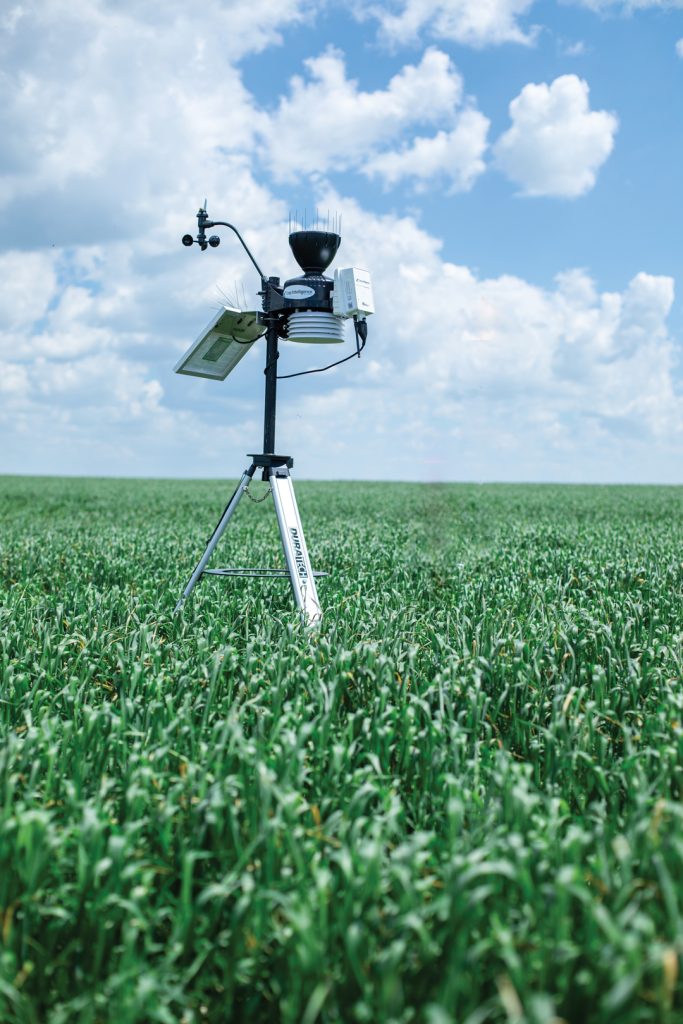
SOIL SMARTS
On a field tour in southern Saskatchewan, Elston Solberg, senior agronomic advisor to South Country Equipment and Crop Intelligence, had an aha moment. Probes indicated the farm’s soil moisture content was unexpectedly high, but it was too late in the season for the farmer to capitalize and boost yield. This led to the 2017 creation of the Regina, SK, company’s Crop Intelligence system, which determines water driven yield potential.
The system collects current soil moisture and rainfall data. Its moisture modelling software also draws upon historical weather information to determine the crop’s expected water use. This allows the farmer and their agronomist to make better crop production decisions, said Andrea De Roo, Crop Intelligence director of agronomy. “It’s built on simple agronomic fundamentals and basic economics, she said. “How much water can your soil texture hold, and how many bushels can you grow per volume of water you have.”
In its first year, Crop Intelligence accurately informed clients they had greater yield potential than dry conditions implied. Though it has typically been good at predicting yield in water-limited conditions, De Roo stressed this is not its goal, but rather to define opportunity for the farmer. And as more data is gathered, this ability is further refined.
Within seven days of seeding, Crop Intelligence places the weather station and sensor hardware in the field. These are removed at freeze-up. Temperature and humidity sensors also help the user evaluate disease and insect risk, which contributes to input decision making. New clients typically start with a couple of stations, said De Roo. To optimally account for the farm’s unique soil profile, they may eventually employ one for every 1,500 to 2,000 acres.
“We’re not just an in-season tool,” said De Roo. “We focus on planning, seeding and your applications. Then you have your harvest data and fall preparation for the following year.” A year-end report provides long-term strategy for production and yield.
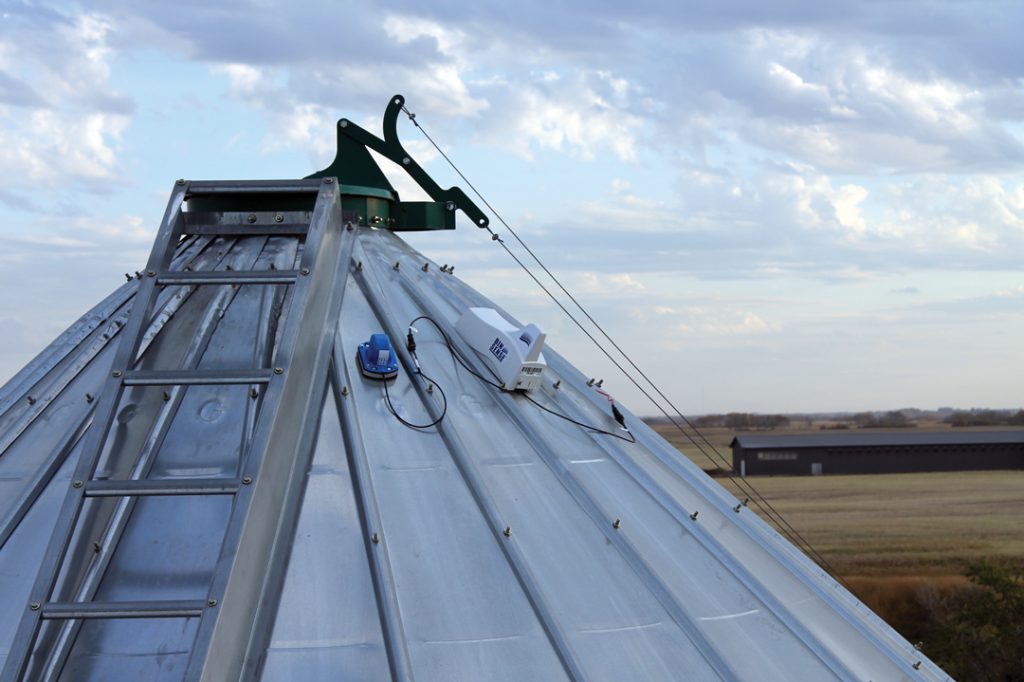
WITHIN THE BIN
When Kyle and Tanner Folk’s snowbird parents were away in Phoenix one winter, some of their binned canola spoiled. Driven to prevent such losses, Kyle launched IntraGrain in 2011. The company created the Bin-Sense cellular-connect grain storage monitoring system and in 2019 became a subsidiary of Calian Agriculture, whose vice-president is Kyle’s brother Tanner.
Bin-Sense now offers four product lines broadly compatible with existing bin cables to monitor temperature, moisture, or both. The Direct and Live versions were launched 10 years ago and modified over time, with Solo and Plus launched recently.
From basic to deluxe, the four products start with Direct, which uses a handheld device that, when plugged into the bin cable, allows the system to connect with a smartphone via Bluetooth and take a reading. Launched in 2022, Bin-Sense Solo provides daily remote readings suitable for farmers who would rather not visit their remote bins each day. Bin-Sense Live delivers hourly readings to the app and dashboard as well as threshold alerts via text and allows the user to control aeration fans. For top-level, autonomous grain monitoring, there is Bin-Sense Plus, available since June. The user sets parameters the system then maintains.
The quartet reflects the maker’s approach to research and development. Valuable innovations aren’t always drastic, said Tanner. “It’s about solving real problems in a simple way. The best path is talking to our customers to understand their needs. Can our angle of approach yield better results by increasing their efficiencies or giving them data they didn’t have before?”
For instance, it may seem counterintuitive, but certain clients use a combination of Bin-Sense products because they store their most volatile products, such as canola harvested in summer heat and slightly wet grain, in small bins. These may require monitoring beyond the basic.
“Bin-Sense is just a hassle-free, wireless grain storage monitoring and automated conditioning system,” said Tanner. “It connects you to your bin conditions whether you’re at home or thousands of miles away.” Even in Phoenix.





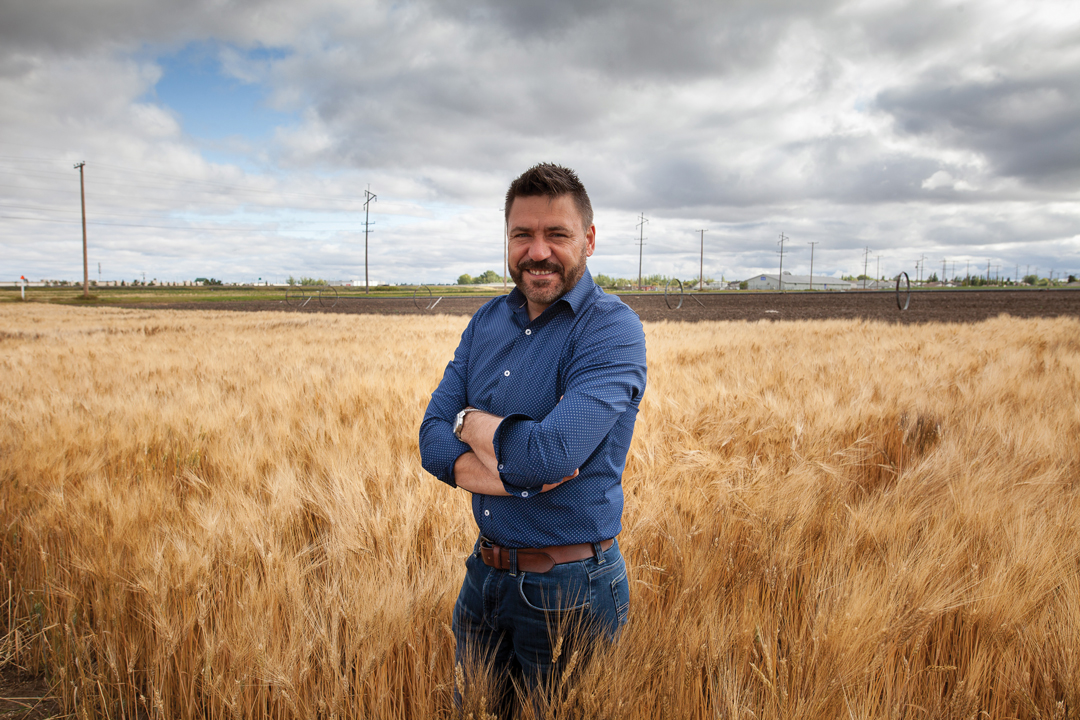

Comments